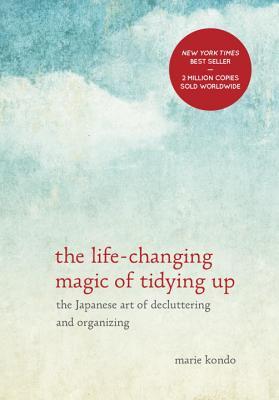| Version 5 (modified by , 8 years ago) (diff) |
|---|
The Life-changing Magic of Tidying Up
Author: Marie Kondo
Mar 14 2017

Review
Verdict:  Recommended. But be ready to filter out some strange anecdotes and slightly whacky techniques.
Recommended. But be ready to filter out some strange anecdotes and slightly whacky techniques.
I first read this book in January and decided to wait to review it till I could figure out if the methods in the book were practical. When I read the book, I was a rather skeptical. Some of the anecdotes make the author seem a few cards short of a full deck. E.g. throwing other people's stuff away without asking them, dumping unwanted stuff on a younger sibling, etc. So, considering that the average person is unlikely to act in such a (inappropriate?) way, I was wary; particularly of the technique where you're expected to touch each thing to determine if it brings you joy. I decided to let the ideas, bereft of the awkward bits, simmer for a few days before deciding to put them into practice.
About a week later, I realized that the ideas could apply, not just for physical possessions, but also for a lot of ideas and thoughts swirling in my head. I'm one of those people who has at least 1 side-project going on in addition to a serious hobby. I was often left feeling like I'd never done enough and there were lots of incomplete projects (mostly software) or things I wanted to get better at (photography, playing the saxophone, etc). Truth be told, I take on way more things than I realistically have time for. These would weigh heavily on my mind whenever I spent time broadly reflecting on how things were going and whether I'd made progress in my various endeavors.
Around the same time, in January, I'd started trying to re-organize my life (yeah, a bit radical) using the techniques outlined in Getting Results the Agile Way and there are some common threads in both books which apply broadly to better self-organization.
Eight weeks later, I re-read the book, this time prepared to filter out the awkward bits and focus on the core. Looking back at the last few weeks to see what I actually used, here's what I've learned:
- Tidying up is about getting rid of things, not finding places to put (hide?) things away.
- I interpreted the part about "keeping only the things that bring joy" along slightly more practical lines of "is this something I will use going forward?" This interpretation seemed a little less "fluffy" to me.
- Tidying by category is an excellent idea. Bringing all things of the same category together gives a clearer big picture and makes it easier to decide what to get rid of; hint: bigger pile means you're likely to dispose off more.
- From the part about dealing with mementos: I found that when applied to my mind, it helped me to eliminate wasteful brain cycles on past, incomplete side-projects and hobbies that I'm unlikely to resume. The focus has shifted firmly to my on-going and near-future side-projects .
- From the technique to designate a place for each thing: I'm a "work hard, play hard" kind of person. The "play hard" part becomes difficult when I don't feel like I've accomplished the "work hard" part; not because I didn't work hard, but because of distractions from work remnants. Separating the two clearly has reduced the interruptions in my head, resulting in better focus and higher productivity.
- I used to store stuff by fine-grained categories which made things more difficult to find. Broad classification for storing items works well. Fewer places to look for things, consequently things are easier to find.
- "Empty your bag everyday" didn't work for me. I have disparate items that I carry in my bag. They get stored in different places and I found that I spent more time putting away and gathering things that needed to go into my bag, sometimes forgetting items.
- Bulk buying is economical and unless I become severely space constrained, I plan to ignore its description as hoarding.
Tidying-up definitely has a positive effect on other parts of my life. There are fewer distractions, less visual noise, and reduced guilt from having to see unused items (in my case mostly books).
